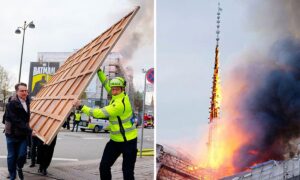
Amid relentless reports of destruction, immense loss of life and a humanitarian crisis in Gaza, the Israel-Hamas war continues to devastate the rich cultural heritage of the tiny exclave. Gaza’s history, much of which is yet to be discovered, spans numerous civilisations, including the Egyptians, Philistines, Babylonians, Greeks, Romans and Byzantines. It was ruled by various Islamic dynasties after the seventh century and by the Ottoman Empire from the 16th century until the British occupation in 1917. According to the Palestinian ministry of tourism and antiquities there are more than 130 registered historic sites in Gaza, excluding historic houses. Three Gazan sites are on Unesco’s World Heritage Tentative List.Specialist visits impossibleThe ministry is seeking to assess the extent of damage to heritage in Gaza but conditions on the ground mean it is impossible for specialists to visit any sites in person, says Jehad Yasin, its general director of excavations and museums. “People cannot move from one place to another so it is still difficult to get information,” he says, but the ministry is closely monitoring news footage and receiving reports from its contacts on the ground where possible.A Spain-based NGO, Heritage for Peace, published a preliminary report on 7 November that listed 104 historic sites as damaged or destroyed. Further cases of destruction have emerged since then. The Palestinian branch of the International Council on Monuments and Sites (Icomos) notably issued a preliminary damage report on 6 December, compiling information from the Palestinian authorities and field colleagues in Gaza.The Icomos Palestine report confirms the complete or partial destruction of nine Gazan heritage sites. However, the branch president, Shireen Allan, says the damage is likely to be far greater than those cases. “Our standards for including sites in the report are very high. We generally confirm by a site visit and pictures but at the moment access to sites is very difficult,” Allan, speaking from Jerusalem, tells The Art Newspaper.Israel began military strikes on Gaza on 7 October after an unprecedented attack by the militant group Hamas killed around 1,200 people and took around 240 hostages, according to the Israeli authorities. During a week-long ceasefire from 24 to 30 November, Hamas freed 105 hostages and 240 Palestinians were released from Israeli prisons. More than 18,500 Palestinians have been killed, according to the Gaza health ministry, while a UN assessment in mid-December estimated that almost 40,000 buildings have been damaged or destroyed. The brief truce allowed Icomos to conduct an assessment of some Gazan heritage sites through collaborations with the Palestinian ministry of tourism and antiquities, the ministry of culture and Gaza’s municipality staff, Allan says.The Icomos report cites the complete destruction of the Central Archives of Gaza City, where thousands of historic documents were kept, and of El Saqqa House, an important cultural centre within a traditional Islamic Mamluk period house constructed in 1661, as well as partial damage to Al Ahli Baptist Hospital, founded in 1882 and thought to be Gaza’s oldest hospital. Yasin confirms the damage to El Saqqa House and the Central Archives. Photographs and videos on social media reviewed by The Art Newspaper show the complete destruction of El Saqqa House. An explosion at Al Ahli Hospital on 17 October reportedly killed several hundred people, according to the Hamas-run Palestinian health ministry.Souq Al Zawiya, one of Gaza City’s oldest and most important markets, has also been completely destroyed, according to Icomos Palestine. The market is located close to the Great Omari Mosque, the oldest and largest mosque in Gaza. The Icomos report recorded only minor damage to the mosque’s minaret. However, on 8 December, just a few days after the report was published, devastating video footage surfaced of the Great Omari Mosque in ruins with only its minaret intact. The mosque dates to the seventh century, when the site was converted from a Byzantine church.“This mosque was a symbol for the people of Gaza, and many had a connection to it,” Yasin says. “I think people feel that the occupation plans to destroy our heritage. What is a symbol or identity for us, they want to demolish.”Icomos Palestine has confirmed damage to other sites with colleagues on the ground, Allan says, but will only publish those findings when it receives the accompanying images—which are delayed because of the lack of internet and electricity in Gaza. Some of these sites include Pasha’s Palace Museum, a 13th-century fortress that was Gaza’s only government-run museum, the 13th-century Othman bin Qashqar Mosque in the al-Zaytoun neighbourhood of Gaza City and Souq Al Qaysariyya, a gold market next to the Great Omari Mosque.The situation in Gaza after [the week-long ceasefire in November] is worse Shiree Allan, president, Palestinian branch of Icomos“The situation in Gaza after the truce is worse. We urge the international community and all cultural organisations to call for an immediate ceasefire to save lives and for urgent intervention to protect cultural properties in accordance with the international conventions,” Allan appeals.Coastal archaeology under threatNot all the destruction to Gaza’s heritage stems from direct military attacks. The water and sewage crisis caused by the war is also affecting coastal archaeology. The United Nations Office for the Coordination of Humanitarian Affairs (OCHA) reported in mid-November that fuel shortages had shut down sewage pumping stations and raw sewage was flowing into the streets in some areas. Sewage has reportedly also been spilling into the Mediterranean and the Wadi Gaza coastal wetlands, which extend from east Gaza to the coast, where it discharges to the sea; according to the OCHA, more than 130,000 cubic metres of wastewater is being discharged into the Mediterranean daily. The Art Newspaper contacted OCHA to confirm whether sewage plants and pumping stations that discharge into the Wadi Gaza were out of operation, but received no response at the time of publication.Water pollution poses a substantial threat to the preservation of underwater archaeology, says Georgia Andreou, the director of the Gaza Maritime Archaeology Project (Gazamap). The initiative was launched in 2022 to examine and survey Gaza’s coastal sites as part of a wider project on endangered maritime cultural heritage in the Middle East and North Africa, run by the University of Southampton and Ulster University in partnership with the University of Oxford. Andreou notes that sites often form artificial reefs with important ecosystems that are also sensitive to changes in water conditions.Gaza’s coastline was already “rapidly deteriorating”, she says, due to erosion caused by the construction of the Aswan Dam on the Nile more than 50 years ago, which exposes and destroys archaeological features before they can be documented. “The sites along this coast will eventually disappear.”Much of the Gaza Strip’s coastal archaeology remains undocumented, and Gazamap’s research, which had documented more than 20,000 surface finds and reconstructed part of the shoreline during the Iron Age, is now on hold because of the war. One of the project’s archaeology students in Gaza and two media collaborators, who were training students and obtaining aerial footage, were killed in the air strikes. Several other students have been displaced. But by monitoring satellite imagery, the researchers have observed bombardments on or near the sites on the coast and near the Wadi Gaza, itself a designated natural site on Unesco’s World Heritage Tentative List. These sites include Taur Ikhbeineh and Tell es-Sakan, fourth to third millennia BC settlements.Anthedon Harbour, Gaza’s first known seaport that was also on Unesco’s Tentative Heritage List, has been bombed and bulldozed, Andreou says. Yasin confirms that the harbour is “completely destroyed”. In 2013, media reports emerged that Hamas had bulldozed part of the port to expand its military training zone. However, The Art Newspaper was unable to confirm this or whether there was an active military area at the port when the war began in October.Unesco actionReports suggest that the third Gazan site on Unesco’s Tentative Heritage List, Tell Umm Amer, has also suffered damage in the war. The condition of the site cannot be confirmed because of severe destruction to its surrounding area and access roads. Located in Al Nusairat village on the coast, around 8.5km south of Gaza City, Tell Umm Amer is notable for the ruins of Saint Hilarion Monastery, one of the oldest and largest monasteries with substantial remains in the Middle East. The ruins “bear a unique testimony to the emergence of Christianity in the region”, says a Unesco spokesperson. Though the site is under the direct supervision of the Palestinian ministry of tourism and antiquities, the spokesperson confirms that Unesco is continuing to monitor the site remotely via satellite data and information transmitted via third parties.Unesco’s Committee for the Protection of Cultural Property in the Event of Armed Conflict met on 14 December and granted Tell Umm Amer “provisional enhanced protection”—the highest level of immunity against attacks established by the 1954 Hague Convention and its Second Protocol, adopted in 1999. If the enhanced protection granted to a cultural property is not respected, the second protocol has established criminal sanctions for violators.Both Israel and Palestine have ratified the 1954 Hague Convention for the Protection of Cultural Property in the Event of Armed Conflict, notes the spokesperson, although Israel has not signed the second protocol. This multilateral treaty stipulates that signatory states shall respect cultural property in their own territories and in the territories of the other parties by refraining from “any act of hostility” against such property, or from any actions that “expose it to destruction or damage in the event of armed conflict”.“We need a ceasefire; everyone is asking for a ceasefire,” Yasin says. Although he recognises that the priority after the war must go to the reconstruction of Gaza and humanitarian efforts, he hopes that there will also be a comprehensive assessment of the damage caused to cultural heritage. “What is lost is part of our history,” he says.


























